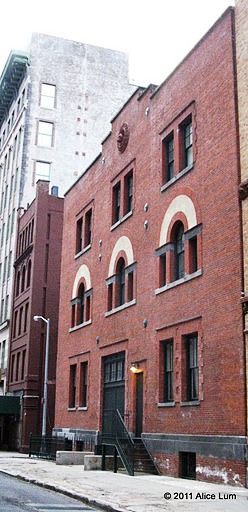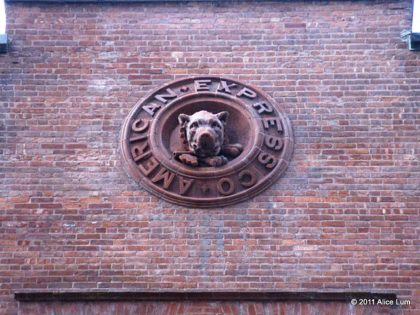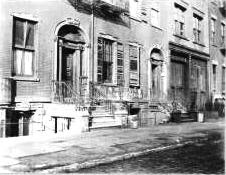The History of 157 Hudson
 Tom Miller, who writes about the history of Manhattan buildings at Daytonian in Manhattan, has allowed Tribeca Citizen to create a database of his Tribeca posts. If you enjoy these, and you will, then you should definitely check out his website, which also has write-ups about buildings all over the island. And don’t miss his book, Seeking New York: The Stories Behind the Historic Architecture of Manhattan—One Building at a Time.
Tom Miller, who writes about the history of Manhattan buildings at Daytonian in Manhattan, has allowed Tribeca Citizen to create a database of his Tribeca posts. If you enjoy these, and you will, then you should definitely check out his website, which also has write-ups about buildings all over the island. And don’t miss his book, Seeking New York: The Stories Behind the Historic Architecture of Manhattan—One Building at a Time.
··································
 Prior to the Civil War, St. John’s Park was one of the most exclusive residential neighborhoods of Manhattan. Along with the fine brick Federal-style residences that lined the square was the majestic 1807 Georgian-style St. John’s Chapel.
Prior to the Civil War, St. John’s Park was one of the most exclusive residential neighborhoods of Manhattan. Along with the fine brick Federal-style residences that lined the square was the majestic 1807 Georgian-style St. John’s Chapel.
But in 1867 Trinity Church sold the park to the Hudson River Railroad for $1 million. The railroad built a freight depot and the elegant neighborhood was no more. Rapidly the homes were replaced with warehouses and small factories that took advantage of the proximity to the railroad.
At the same time, private express mail companies like Adams Express, Wells Fargo, and American Express were rapidly growing. Founded in 1850 in Albany, American Express established its headquarters in Manhattan at Jay and Hudson Streets and essentially enjoyed a monopoly on the shipment of express goods in the state for two decades.
Even before the freight depot was built, American Express erected at two-story stable at Nos. 4 to 8 Hubert Street in 1866, designed by architects Ritch & Griffiths. The stark brick building did not pretend to be anything other than a utilitarian building with little ornamentation.
The newly-completed Hudson River Railway depot sat approximately one block away, directly across from the house at No. 157 Hudson Street. The owner of the house was quick to react, along with other wealthy residents. The commodious residence—25 feet wide—sat on a lot that extended 109 feet back, in the middle of the block between Hubert and Laight Streets. The homeowner sold the property on April 20, 1870 for $24,750 in cash, which The New York Times deemed “very cheap at the price.”
While American Express was operating its stable from Hubert Street, the United States Army established a cavalry rendezvous local recruiting office around the corner at No. 157 Hudson Street in the 1880s.
Although funds transfers and long-distance finance had already become an important part of the firm’s operations—the American Express Travelers Cheque was copyrighted in 1891—American Express recognized the need to enlarge the Hubert Street facility in 1898. Architect Edward Hale Kimball was commissioned to extend the stable through the entire block along Collier Street to Laight Street.
It was most likely at this time that the entire structure was increased to three stories. Kimball updated the original façade, melding it with the addition by matching the keyed window surrounds and introducing a mixture of Romanesque Revival and Renaissance Revival styles; both highly popular at the time.
 The American Express bulldog appears in terra cotta relief on both the Laight and Hubert Street facades.
The American Express bulldog appears in terra cotta relief on both the Laight and Hubert Street facades.
··································
On both the Laight Street and Hubert Street sides, Kimball added a robust terra cotta bulldog logo in a rondel under a shallow stepped parapet. The renovations were completed a year later, in 1899.
Only three years later, in 1902, the building was enlarged again. Architect Charles Romeyn widened the Laight Street side. He also added a long, narrow extension through the middle of the block to No. 157 Hudson Street where the Cavalry had been headquartered, creating a T-shaped structure.
The days of horses and drays for the American Express Company were numbered, however. In 1913, the parcel post system was established, wielding a significant blow to the express companies. By 1918, American Express was gone and a railroad freight firm, the American Railway Express Company, was using the building.
The building was renovated again in 1946 when architect Henry G. Harrington remodeled it for use as the factory of the First Machinery Corporation, manufacturers of plastic and rubber products. Harrington also remodeled the Hudson Street façade by adding stone pilasters and arches framing the entrances.
 Harrington’s addition at No. 157 Hudson,forming the base of the T-shaped building (seen far right), stands next to two derelict Federal homes, still remarkably intact in 1922. Their marble arches and lintels, even their elegant entranceways and iron railings are still in place.
Harrington’s addition at No. 157 Hudson,forming the base of the T-shaped building (seen far right), stands next to two derelict Federal homes, still remarkably intact in 1922. Their marble arches and lintels, even their elegant entranceways and iron railings are still in place.
··································
First Machinery Corporation ran its factory here through the 1950s.
As Tribeca experienced a renaissance, the old American Express stables saw change. Where horses and then machinery were once housed, No. 157 Hudson was now a hot night spot. Three different nightclubs—Headley, Vinyl and Area—were here. In 1997, despite more than one shooting at Vinyl, the club’s owner Nick DiTomasso said, “…they’re just dancing. It’s all about dancing.”
After struggling for awhile with the Landmarks Preservation Commission over a proposed three-story rooftop addition, Moore settled for a compromise of a two-story addition invisible from the street. The resulting multifamily structure had 17 unique loft apartments averaging 3,000 square feet each.
One apartment went a bit further. Called “Marble House,” the 9,200 square foot triplex had an entrance on Collister Street to the rear, four bedrooms, five baths, a kitchen sink “quarried from one 2-ton piece of Carrara marble,” a below-ground swimming pool and a price tag of $24.5 million in 2009. (In 2011 most apartments were going for a more affordable $3 million or so.)
Nearly a century and a half after the original stable was built, it serves as a fine example of reuse of an historic property.
··································
Photo credits from top: Alice Lum (2); unknown.












